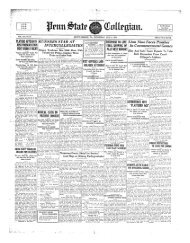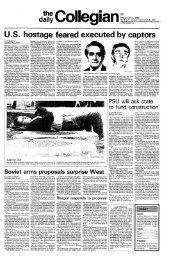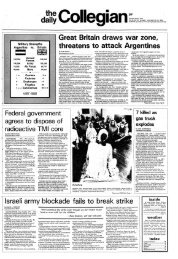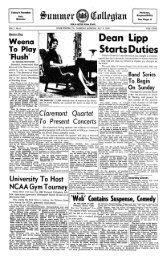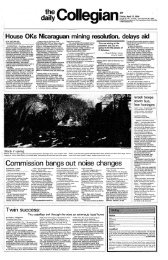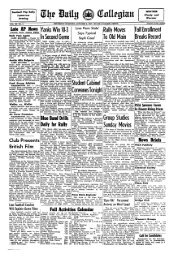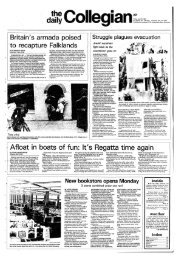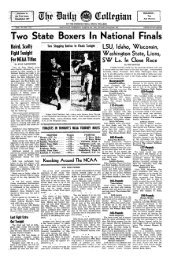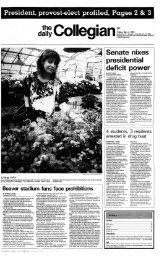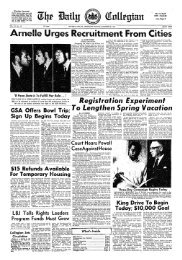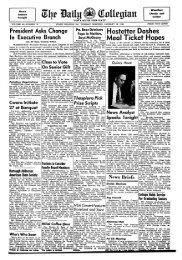9 - Digitized Collections
9 - Digitized Collections
9 - Digitized Collections
Create successful ePaper yourself
Turn your PDF publications into a flip-book with our unique Google optimized e-Paper software.
CATA to<br />
fiSe suit<br />
against<br />
corrapiex<br />
The Centre Area Transportation<br />
Authority last night approved<br />
plans to file suit against Parkway<br />
Plaza Apartments for an alleged<br />
breach of contract by the complex.<br />
CATA General manager Kevin<br />
Abbey said the suit alleges Parkway<br />
Plaza did not make full payment<br />
for its 850 residents' bus<br />
passes.<br />
Abbey said Friday was the final<br />
day Parkway Plaza had to honor<br />
its contract with CATA. He said<br />
CATA sent Parkway Plaza a letter<br />
Feb. 19, notifying them of the 30-<br />
day limit.<br />
Parkway Plaza spokesmen<br />
could not be reached for comment.<br />
But Parkway Plaza Controller<br />
Sara Zabriskie said on March 19,<br />
CATA allegedly broke the contract.<br />
Zabriskie said Parkway<br />
Plaza had met all contract<br />
agreements and did not believe it<br />
must pay a 100 percent, $75 increase<br />
for residents' bus passes<br />
the third year of the contract.<br />
CATA posted notices on buses<br />
and shelters for Parkway Plaza<br />
and Logan House residents<br />
March 19, notifying them that the<br />
authority planned to confiscate the<br />
passes on March 22.<br />
In response, Parkway Plaza notified<br />
its tenants that it would<br />
provide money for them to buy<br />
three-month CATA passes for the<br />
remainder of the term of the original<br />
pass.<br />
Abbey said CATA sent a letter<br />
March 21, notifying Parkway Plaza<br />
that the authority did not plan<br />
to confiscate passes but wanted<br />
the complex to make full payment.<br />
Abbey said the authority received<br />
two letters stating Parkway<br />
Plaza would attend CATA's<br />
board meetings. However, he said<br />
no one representing Parkway Plaza<br />
has attended their meetings<br />
this year.<br />
Someone dropped off a box of<br />
about 540 bus passes at the authority's<br />
dispatch office yesterday,<br />
Abbey said. A Parkway^ Plaza<br />
memo was attached and the words<br />
"passes being turned in per individual"<br />
were written on it, he<br />
added.<br />
Abbey said CATA did not request<br />
the passes be returned, and<br />
that CATA will continue actions to<br />
recover payment.<br />
—by K.J. Mapes<br />
Bus stop plan hits yellow light<br />
By DEBBIE SKLAR<br />
Collegian Staff Writer<br />
Plans for the relocation of the<br />
College Avenue and South Allen<br />
Street bus stop to the corner of<br />
Fraser Street and College reached<br />
a snag when the University's engineering<br />
department questioned the<br />
effects of the new stop on classroom<br />
experiments taking place in<br />
Hammond Building.<br />
The move would relieve congestion<br />
of the College/Allen intersection<br />
making it safer for pedestrians<br />
while clearing the view of Old<br />
Main, said Ralph Zilly, University<br />
vice president of business.<br />
Zilly said the engineering department<br />
may have problems with the<br />
stop location in front of Hammond<br />
because sound and vibrations that<br />
accompany the bus stop may hinder<br />
classroom experiments.<br />
Kevin Abbey, the Centre Area<br />
Transportation Authority general<br />
manager, said the relocation,<br />
which will affect both CATA and<br />
Campus Loop buses, has been in<br />
the preliminary stage for four<br />
years and no problems had been<br />
encountered until the engineering<br />
department expressed its concerns.<br />
A spokesman for the engineering<br />
department refused to comment on<br />
the situation.<br />
He added that a temporary relocation<br />
is now being planned so tests<br />
can be completed by the University's<br />
Department of Physical Plant<br />
at the request of the engineering<br />
department. The tests will show<br />
the overall effects of the relocation<br />
on classroom experiments.<br />
Although no date for the move<br />
has been set, Zilly said a test has<br />
been conducted at the new stop site<br />
on sound and vibrations and a<br />
second testing will be conducted<br />
after the temporary move to find<br />
the actual effects on the class experiments.<br />
If the tests cause negative effects<br />
on the classroom experiments the<br />
move will not become permanent,<br />
he said.<br />
Abbey said, "The move will provide<br />
the town with a safer intersection,<br />
shelter during the rain and<br />
aesthetic benefits to Old Main. The<br />
only negative affect will be the net<br />
loss of six to eight parking spaces<br />
(near Hammond Building)."<br />
The parking meters now at the<br />
proposed site of the new bus stop<br />
will be relocated to the old bus stop,<br />
he added.<br />
CATA and the University would<br />
be involved in the relocation with<br />
Penn State contributing the land,<br />
design work and the assisting in<br />
finding an appropriate construction<br />
bid, Abbey said.<br />
"The design plans would have to<br />
be approved by both the (University)<br />
Board of Trustees and the University<br />
administration because it<br />
involves University land," he<br />
added.<br />
The project will be funded by<br />
grants CATA received — 80 percent<br />
federal funds, about 16 percent<br />
state funds and about 3<br />
percent local funds. No University<br />
money will be spent.<br />
PSU part of system<br />
to study the Earth<br />
By ADAM BOONE<br />
Collegian Science Writer<br />
A nationwide network of universities,<br />
including Penn State, may help<br />
fvirther the understanding of the<br />
Earth's interior.<br />
Shelton S. Alexander, University<br />
professor of geophysics, said Incorporated<br />
Research Institutions for Seismologys<br />
hopes to link seismographic<br />
research stations to create a network<br />
covering the continent.<br />
The seismograph network will link<br />
earthquake watch stations, eventually<br />
through satellite communications,<br />
to facilitate extensive earthquake<br />
observations, Alexander said.<br />
Alexander, also vice president of<br />
the IRIS board of directors, said the<br />
group hopes to use the PASSCAL<br />
system — a portable series of seismograph<br />
detectors that can provide<br />
more detailed images of the Earth's<br />
crust than previously were possible.<br />
The system uses 1,000 individual<br />
sensors to detect tremors in the surface<br />
and produces, through sophisticated<br />
computer manipulation, a<br />
detailed three-dimensional image of<br />
the area immediately below the<br />
Earth's surface.<br />
"It's like a telescope to look into the<br />
Earth and focus on specific objects,"<br />
he said.<br />
The images are made possible because<br />
earthquake waves have different<br />
properties when they travel<br />
through different materials.<br />
The system may detect natural<br />
Earth tremors or artificially created<br />
vibrations like those used in the oil<br />
industry to detect oil reserves, Alexander<br />
said. However, the new technology<br />
used in the project makes it<br />
possible to refine the resolution of the<br />
deep-Earth images, providing more<br />
detail than the systems used by the oil<br />
industry.<br />
The seismograph network and<br />
PASSCAL will be supplemented by a<br />
computer network that will link all<br />
member institutions to a special<br />
group of "super computers" like<br />
those located in Princeton, N.J., he<br />
said. The computer network will allow<br />
seismology researchers anywhere<br />
in the world to instantly access<br />
the gathered data from the IRIS<br />
project, he said.<br />
Robert Masse, branch-chief of the<br />
U.S. Geological Survey branch in<br />
Denver, Colo., said the IRIS project<br />
was begun by the individual research<br />
institutions with backing from the<br />
National Science Foundation. Although<br />
the IRIS foundation has no<br />
direct affilitation to the USGS, the<br />
two groups will work as partners in<br />
their attempt to learn more about the<br />
nature of the Earth's interior, he<br />
said.<br />
Masse said the IRIS project has<br />
had a very positive effect on seismographic<br />
research.<br />
Alexander said IRIS was organized<br />
in 1984 and now includes more than 48<br />
institutions nation-wide.<br />
The international interest has<br />
made a federation of world-wide seismograph<br />
stations a definite possibility,<br />
Masse said, adding that a global<br />
network could enhance understanding<br />
of the Earth's interior.<br />
"(Because of IRIS,) global .coverage<br />
will improve much faster than<br />
the USGS alone will be able to do," he<br />
said.<br />
Treading lightly<br />
VJM&S&<br />
i§§<br />
WW,<br />
aft<br />
* ¦ ./ X ' *uT \<br />
m<br />
iH<br />
•' A-VOsZ<br />
mvmii ( . * i<br />
Christopher Lutz (freshman-liberal arts) puts his heart and 'sole' into<br />
studying as he enjoys some early spring sunshine on the steps of Pattee.<br />
*<br />
I<br />
* ,<br />
44<br />
M<br />
Collegian Photo/ Dan Olsekl<br />
Many students have been hitting the books out in the open air as warming<br />
temperatures hint of things to come.<br />
General ed proposal up for vote<br />
New general education legislation,<br />
which would require students to take<br />
a courses in four areas of academic<br />
studies, will be voted on by the Faculty<br />
Senate today at \ p.m. in 101<br />
Kern.<br />
Laurie Dieffenbach, student member<br />
of the senate's General Education<br />
Implementation Subcommittee, said<br />
that if the legislation is passed, students<br />
will have to take three credits<br />
of the humanities, arts, natural sciences,<br />
and social and behavorial sciences.<br />
• Breadth courses introduce and integrate<br />
major areas of knowledge,<br />
according to the subcommittee's report<br />
to the senate.<br />
Jerry Covert, subcommittee chairman,<br />
said exceptions will be made to<br />
allow certain degree programs to<br />
bypass breadth courses in their<br />
areas.<br />
He said this is "considerably different<br />
from the past when students were<br />
more or less forced into taking<br />
courses whether or not they were<br />
relevant to the student."<br />
However, he noted that because the<br />
actual course proposals for general<br />
education have not been decided on,<br />
no bypasses have been approved yet.<br />
Covert said all students could appeal<br />
to their deans if they want to<br />
bypass a breadth course. .<br />
If the legislation is approved by the<br />
senate, it will be implemented as part<br />
of the general education program,<br />
scheduled to begin Summer Session<br />
1988. — by Carolyn. Sorisio<br />
Faculty becoming entrepreneurs to aid business<br />
By PETER D. TENNY<br />
Collegian Business Writer<br />
Some University professors are taking<br />
their expert knowledge outside the classroom<br />
and becoming "faculty entrepreneurs" by<br />
conducting research, advancing academics<br />
and solving practical problems in the private<br />
sector, said the Dean for Research in the<br />
College of Business Administration.<br />
, Paul Rigby said University faculty are<br />
addressing real world problems by participating<br />
in the Division of Research of the<br />
College of Business Administration.<br />
"The Division of Research is an incubator<br />
designed to develop and facilitate faculty<br />
research, but a predominate problem is that<br />
research involving extensive empirical data<br />
is expensive, and if the funds aren't there the<br />
research can't be done," Rigby said.<br />
The Division of Research eliminates this<br />
obstacle by securing the external support of<br />
foundations and grants from private industry.<br />
This approach is similar to the way entrepreneurs<br />
would undertake a project they<br />
would like to do, but don't have the financial<br />
resources, he said.<br />
"Our objective is to encourage and develop<br />
'faculty entrepreneurship' by securing external<br />
funding for research," Rigby said. "We<br />
are a vehicle, which enables important research<br />
to be done, which otherwise might not<br />
be possible because of cost considerations.<br />
Last year external funding for research at<br />
the University exceeded $1 million, and at<br />
least 50 foundations and companies were and<br />
still are involved including: the National<br />
Science Foundation, E.I. duPont de Nemours<br />
& Co., General Electric, Westinghouse, Rockwell<br />
International, Control Data, Chrysler,<br />
Price Waterhouse, General Dynamics, Polaroid,<br />
Union Carbide, IBM, and state and local<br />
governments.<br />
While those companies often have their<br />
own research and development programs,<br />
they participate in University research programs<br />
because they want to see research<br />
done in a particular area. Companies also<br />
support research projects because of strong<br />
University support for doing research in a<br />
certain area and the companies can participate<br />
in the research agenda through an<br />
advisory board.<br />
Rigby stressed that "we are not engaged in<br />
consulting contracts for these companies. We<br />
do research for the discipline, not for the<br />
company. But sometimes the company can<br />
vicariously benefit from the increased level<br />
of understanding."<br />
Rigby, a professor of management science<br />
and the overall director of the Division of<br />
Research, said, "we have found it easier to<br />
obtain funding for a program rather than an<br />
individual person or project."<br />
For this reason, the Division of Research is<br />
'We enable important research to be done.'<br />
—Paul Rigby, dean for research in the College of Business<br />
Administration<br />
broken down into seven different centers or<br />
institutes that include: the Institute for the<br />
Study of Business Markets, the Center for<br />
Regional Business Analysis, the Center for<br />
Issues Management Research, the Blankman<br />
Strategic Decision Making Program, the<br />
Institute for Real Estate Studies, the Pension<br />
and Welfare Research Program, and the<br />
Center for the Management of Technological<br />
and Organizational Change.<br />
All are different in their focuses, but similar<br />
in their objectives, which are to identify<br />
problem areas of mutual interest between the<br />
business and academic communities, determine<br />
what must be done and then develop<br />
ways of dealing with the problems.<br />
James Dean Jr., the assistant director of<br />
the Center for the Management of Technological<br />
and Organizational Change, said the<br />
focus of their research is on the effects of<br />
Advanced Manufacturing Technology, including<br />
robotics and computer integrated<br />
manufacturing. CMTOC has done research<br />
projects in areas of organizational interfaces,<br />
which studies how different components in an<br />
organization are interdependent. In addition,<br />
CMTOC studies the justification decision<br />
process of investment in advanced manunfacturing<br />
technology, Dean said.<br />
"Mostly companies do purely technical<br />
research, ours is applied organizational research,"<br />
said Dean, also an assistant professor<br />
of organizational behavior.<br />
Arnold Shapiro, associate professor of actuarial<br />
science and director of the Pension<br />
and Welfare Research Program, said "we do<br />
applied research in the area of actuarial cost<br />
methods and assumptions, and employee<br />
benefits such as employee stock ownership<br />
and pension plans."<br />
William Anderson, the assistant director of<br />
the Center for Regional Business Analysis,<br />
said, "the center's research concerns a continuous<br />
analysis and monitoring of the Pennsylvania<br />
economy.<br />
"We provide a monthly overview of the<br />
area's entire economic situation, which includes<br />
research on industry trends, unemployment,<br />
income levels, consumer price<br />
indices, economic growth and decline, seasonal<br />
adjustments, forecasting and economic<br />
effects of enterprise development," Anderson<br />
said.<br />
These research projects are not privy to<br />
faculty in the College of Business. The Center<br />
for Regional Business Analysis, for example,<br />
did a study that included not only business<br />
professors, but encompassed faculty from<br />
the colleges of Agriculture, The Liberal Arts,<br />
Human Development, and Earth and Mineral<br />
Sciences as well, Rigby said.<br />
The research often erases departmental<br />
lines and crosses college boundaries, Rigby<br />
said.<br />
"You can't study organizations in a vacuum,"<br />
Dean added. The idea is to develop a<br />
university without walls where everyone<br />
within the university and outside of it can<br />
learn.<br />
"Developing faculty entrepreneurs has<br />
also enhanced academic-industry relations,"<br />
Rigby said. "Although academia and industry<br />
have different objectives, we've been able<br />
to work together and make this a joint venture."<br />
The approach of developing "faculty<br />
entrepreneurship" has worked well at a number<br />
of other universities, including a Finance<br />
Institute at the University of Washington, the<br />
Center for Research in Technology and Strategy<br />
at Drexel University, and projects on<br />
human resources and strategic planning at<br />
Columbia University.




